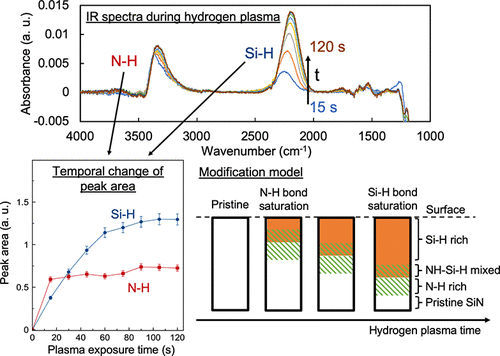当前位置:
X-MOL 学术
›
ACS Appl. Mater. Interfaces
›
论文详情
Our official English website, www.x-mol.net, welcomes your
feedback! (Note: you will need to create a separate account there.)
In Situ Monitoring of Surface Reactions during Atomic Layer Etching of Silicon Nitride Using Hydrogen Plasma and Fluorine Radicals
ACS Applied Materials & Interfaces ( IF 8.3 ) Pub Date : 2019-09-25 , DOI: 10.1021/acsami.9b11489 Kazuya Nakane , René H. J. Vervuurt 1 , Takayoshi Tsutsumi , Nobuyoshi Kobayashi , Masaru Hori
ACS Applied Materials & Interfaces ( IF 8.3 ) Pub Date : 2019-09-25 , DOI: 10.1021/acsami.9b11489 Kazuya Nakane , René H. J. Vervuurt 1 , Takayoshi Tsutsumi , Nobuyoshi Kobayashi , Masaru Hori
Affiliation

|
The atomic layer etching (ALE) of silicon nitride (SiN) via a hydrogen plasma followed by exposure to fluorine radicals was investigated by using in situ spectroscopic ellipsometry and attenuated total reflectance Fourier transform infrared (FTIR) spectroscopy to examine the surface reactions and etching mechanism. FTIR spectra of the surface following exposure to the hydrogen plasma showed an increase in the concentration of Si–H and N–H bonds, although the N–H bond concentration plateaued more quickly. In contrast, during fluorine radical exposure, the Si–H bond concentration decreased more rapidly. Secondary ion mass spectrometry demonstrated that the nitrogen atom concentration was decreased to a depth of 4 nm from the surface after the hydrogen plasma treatment and indicated a structure consisting of N–H rich, Si–H rich, and mixed layers. This indicated that Si–H bonds were primarily present near the surface, while N–H bonds were mainly located deeper into the film. The formations of the N–H and Si–H rich layers are important phenomena associated with modification by hydrogen plasma and fluorine radical etching, respectively.
中文翻译:

氢等离子体和氟自由基对氮化硅原子层刻蚀过程中表面反应的原位监测
通过原位研究了通过氢等离子体对氮化硅(SiN)进行原子层蚀刻(ALE),然后暴露于氟自由基的情况。光谱椭圆偏振和衰减全反射傅里叶变换红外(FTIR)光谱来检查表面反应和蚀刻机理。暴露于氢等离子体后,表面的FTIR光谱显示Si–H和N–H键的浓度增加,尽管N–H键的浓度趋于平稳。相反,在氟自由基暴露期间,Si-H键浓度下降得更快。二次离子质谱分析表明,在进行氢等离子体处理后,氮原子的浓度降低至距表面4 nm的深度,并表明其结构由富N–H,富Si–H和混合层组成。这表明Si–H键主要存在于表面附近,而N–H键主要位于膜的更深处。
更新日期:2019-09-26
中文翻译:

氢等离子体和氟自由基对氮化硅原子层刻蚀过程中表面反应的原位监测
通过原位研究了通过氢等离子体对氮化硅(SiN)进行原子层蚀刻(ALE),然后暴露于氟自由基的情况。光谱椭圆偏振和衰减全反射傅里叶变换红外(FTIR)光谱来检查表面反应和蚀刻机理。暴露于氢等离子体后,表面的FTIR光谱显示Si–H和N–H键的浓度增加,尽管N–H键的浓度趋于平稳。相反,在氟自由基暴露期间,Si-H键浓度下降得更快。二次离子质谱分析表明,在进行氢等离子体处理后,氮原子的浓度降低至距表面4 nm的深度,并表明其结构由富N–H,富Si–H和混合层组成。这表明Si–H键主要存在于表面附近,而N–H键主要位于膜的更深处。















































 京公网安备 11010802027423号
京公网安备 11010802027423号